

Secrets of the Creative Brain. As a psychiatrist and neuroscientist who studies creativity, I’ve had the pleasure of working with many gifted and high-profile subjects over the years, but Kurt Vonnegut—dear, funny, eccentric, lovable, tormented Kurt Vonnegut—will always be one of my favorites.
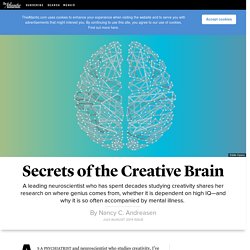
Kurt was a faculty member at the Iowa Writers’ Workshop in the 1960s, and participated in the first big study I did as a member of the university’s psychiatry department. I was examining the anecdotal link between creativity and mental illness, and Kurt was an excellent case study. He was intermittently depressed, but that was only the beginning. His mother had suffered from depression and committed suicide on Mother’s Day, when Kurt was 21 and home on military leave during World War II. Scott Barry Kaufman, Ph.D.: After the Show: The Many Faces of the Performer. "Do I contradict myself?

/ Very well then I contradict myself, / (I am large, I contain multitudes.) " - Walt Whitman Recounting his recording sessions with the young Michael Jackson, famed record producer Quincy Jones remembers that "Michael was so shy, he'd sit down and sing behind the couch with his back to me while I sat with my hands over my eyes -- and the lights off. " The Complexity of the Creative Personality.
Researcher Mihaly Csikszentmihalyi includes in his books and other writings descriptions of the diversity and multiple characteristics of creative people.
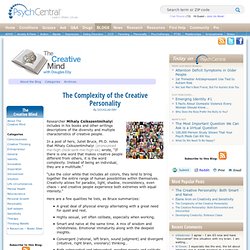
In a post of hers, Juliet Bruce, Ph.D. notes that Mihaly Csikszentmihalyi (pronounced me-high chick-sent-me-high-ee) wrote, “If there is one word that makes creative people different from others, it is the word complexity. Instead of being an individual, they are a multitude.” “Like the color white that includes all colors, they tend to bring together the entire range of human possibilities within themselves. Creativity allows for paradox, light, shadow, inconsistency, even chaos – and creative people experience both extremes with equal intensity.” Here are a few qualities he lists, as Bruce summarizes: A great deal of physical energy alternating with a great need for quiet and rest.Highly sexual, yet often celibate, especially when working.Smart and naïve at the same time. The Unleashed Mind: Why Creative People Are Eccentric. He is one of the world’s best known and most successful entrepreneurs, with hundreds of patents to his name—including the Segway scooter.
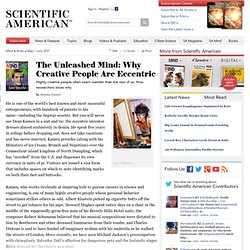
But you will never see Dean Kamen in a suit and tie: the eccentric inventor dresses almost exclusively in denim. He spent five years in college before dropping out, does not take vacations and has never married. Kamen presides (along with his Ministers of Ice Cream, Brunch and Nepotism) over the Connecticut island kingdom of North Dumpling, which has “seceded” from the U.S. and dispenses its own currency in units of pi. Visitors are issued a visa form that includes spaces on which to note identifying marks on both their face and buttocks.
Kamen, who works tirelessly at inspiring kids to pursue careers in science and engineering, is one of many highly creative people whose personal behavior sometimes strikes others as odd. Select an option below: Customer Sign In *You must have purchased this issue or have a qualifying subscription to access this content. 18 Things Highly Creative People Do Differently. This list has been expanded into the new book, “Wired to Create: Unravelling the Mysteries of the Creative Mind,” by Carolyn Gregoire and Scott Barry Kaufman. Creativity works in mysterious and often paradoxical ways. Creative thinking is a stable, defining characteristic in some personalities, but it may also change based on situation and context. Inspiration and ideas often arise seemingly out of nowhere and then fail to show up when we most need them, and creative thinking requires complex cognition yet is completely distinct from the thinking process.
Neuroscience paints a complicated picture of creativity. As scientists now understand it, creativity is far more complex than the right-left brain distinction would have us think (the theory being that left brain = rational and analytical, right brain = creative and emotional). While there’s no “typical” creative type, there are some tell-tale characteristics and behaviors of highly creative people. They daydream. Why “Psychological Androgyny” Is Essential for Creativity. By Maria Popova “Creative individuals are more likely to have not only the strengths of their own gender but those of the other one, too.”
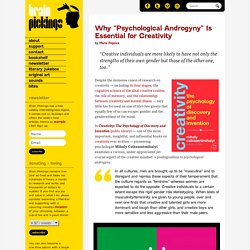
Despite the immense canon of research on creativity — including its four stages, the cognitive science of the ideal creative routine, the role of memory, and the relationship between creativity and mental illness — very little has focused on one of life’s few givens that equally few of us can escape: gender and the genderedness of the mind. In Creativity: The Psychology of Discovery and Invention (public library) — one of the most important, insightful, and influential books on creativity ever written — pioneering psychologist Mihaly Csikszentmihalyi examines a curious, under-appreciated yet crucial aspect of the creative mindset: a predisposition to psychological androgyny.
Illustration by Yang Liu from 'Man Meets Woman,' a pictogram critique of gender stereotypes. Click image for details. Illustration from the 1970 satirical book 'I’m Glad I’m a Boy! 10 Paradoxical Traits Of Creative People. Editor's Note: This is one of the most-read leadership articles of 2013.
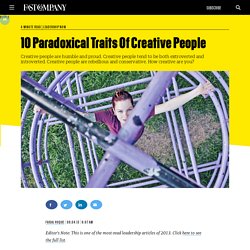
Click here to see the full list. I frequently find myself thinking about whether I am an artist or an entrepreneur. I am simply trying my best to create my own unique path. It is safe to say that more and more entrepreneurs are artists, and artists of all kinds are entrepreneurs.